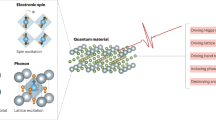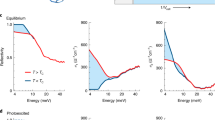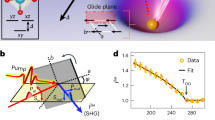Abstract
Optically excited quantum materials exhibit non-equilibrium states with remarkable emergent properties, but these phenomena are usually transient, decaying on picosecond timescales and limiting practical applications. Advancing the design and control of non-equilibrium phases requires the development of targeted strategies to achieve long-lived, metastable phases. Here we report the discovery of symmetry-protected electronic metastability in the model cuprate ladder Sr14Cu24O41. Using femtosecond resonant X-ray scattering and spectroscopy, we show that this metastability is driven by a transfer of holes from chain-like charge reservoirs into the ladders. This ultrafast charge redistribution arises from the optical dressing and activation of a hopping pathway that is forbidden by symmetry at equilibrium. Relaxation back to the ground state is, hence, suppressed after the pump coherence dissipates. Our findings highlight how dressing materials with electromagnetic fields can dynamically activate terms in the electronic Hamiltonian, and provide a rational design strategy for non-equilibrium phases of matter.
This is a preview of subscription content, access via your institution
Access options
Access Nature and 54 other Nature Portfolio journals
Get Nature+, our best-value online-access subscription
$32.99 / 30 days
cancel any time
Subscribe to this journal
Receive 12 print issues and online access
$259.00 per year
only $21.58 per issue
Buy this article
- Purchase on SpringerLink
- Instant access to full article PDF
Prices may be subject to local taxes which are calculated during checkout






Similar content being viewed by others
Data availability
The data that support the findings of this study are present in the article and its Supplementary Information. Source data for figures in the main text are available via Figshare at https://doi.org/10.6084/m9.figshare.28851200.v1. Any additional data are available from the corresponding authors upon request.
Code availability
The codes used for DMRG and CuO6 cluster calculations are available from the corresponding authors upon request.
References
Basov, D. N., Averitt, R. D. & Hsieh, D. Towards properties on demand in quantum materials. Nat. Mater. 16, 1077–1088 (2017).
Wang, Y. H., Steinberg, H., Jarillo-Herrero, P. & Gedik, N. Observation of Floquet-Bloch States on the surface of a topological insulator. Science 342, 453–457 (2013).
McIver, J. W. et al. Light-induced anomalous Hall effect in graphene. Nat. Phys. 16, 38–41 (2020).
Shin, D. et al. Phonon-driven spin-Floquet magneto-valleytronics in MoS2. Nat. Commun. 9, 638 (2018).
Disa, A. S. et al. Polarizing an antiferromagnet by optical engineering of the crystal field. Nat. Phys. 16, 937–941 (2020).
Fausti, D. et al. Light-induced superconductivity in a stripe-ordered cuprate. Science 331, 189–191 (2011).
Mitrano, M. et al. Possible light-induced superconductivity in K3C60 at high temperature. Nature 530, 461–464 (2016).
Koshihara, S., Tokura, Y., Mitani, T., Saito, G. & Koda, T. Photoinduced valence instability in the organic molecular compound tetrathiafulvalene-p-chloranil (TTF-CA). Phys. Rev. B 42, 6853–6856 (1990).
Kiryukhin, V. et al. An X-ray-induced insulator–metal transition in a magnetoresistive manganite. Nature 386, 813–815 (1997).
Fiebig, M., Miyano, K., Tomioka, Y. & Tokura, Y. Visualization of the local insulator-metal transition in Pr0.7Ca0.3MnO3. Science 280, 1925–1928 (1998).
Zhang, J. et al. Cooperative photoinduced metastable phase control in strained manganite films. Nat. Mater. 15, 956–960 (2016).
Stojchevska, L. et al. Ultrafast switching to a stable hidden quantum state in an electronic crystal. Science 344, 177–180 (2014).
Stoica, V. et al. Optical creation of a supercrystal with three-dimensional nanoscale periodicity. Nat. Mater. 18, 377–383 (2019).
Cremin, K. A. et al. Photoenhanced metastable c-axis electrodynamics in stripe-ordered cuprate La1.885Ba0.115CuO4. Proc. Natl Acad. Sci. USA 116, 19875–19879 (2019).
Nova, T. F., Disa, A. S., Fechner, M. & Cavalleri, A. Metastable ferroelectricity in optically strained SrTiO3. Science 364, 1075–1079 (2019).
Sie, E. J. et al. An ultrafast symmetry switch in a Weyl semimetal. Nature 565, 61–66 (2019).
Disa, A. et al. Photo-induced high-temperature ferromagnetism in YTiO3. Nature 617, 73–78 (2023).
Budden, M. et al. Evidence for metastable photo-induced superconductivity in K3C60. Nat. Phys. 17, 611–618 (2021).
Vogelgesang, S. et al. Phase ordering of charge density waves traced by ultrafast low-energy electron diffraction. Nat. Phys. 14, 184–190 (2018).
Zong, A. et al. Evidence for topological defects in a photoinduced phase transition. Nat. Phys. 15, 27–31 (2019).
Gerasimenko, Y. A. et al. Quantum jamming transition to a correlated electron glass in 1T-TaS2. Nat. Mater. 18, 1078–1083 (2019).
von der Linde, D., Glass, A. M. & Rodgers, K. F. Multiphoton photorefractive processes for optical storage in LiNbO3. Appl. Phys. Lett. 25, 155–157 (1974).
Zhang, X. et al. Light-induced electronic polarization in antiferromagnetic Cr2O3. Nat. Mater. 23, 790–795 (2024).
Shan, J.-Y. et al. Giant modulation of optical nonlinearity by Floquet engineering. Nature 600, 235–239 (2021).
Sato, S. A. et al. Microscopic theory for the light-induced anomalous Hall effect in graphene. Phys. Rev. B 99, 214302 (2019).
Lenarčič, Z., Eckstein, M. & Prelovšek, P. Exciton recombination in one-dimensional organic Mott insulators. Phys. Rev. B 92, 201104 (2015).
Mitrano, M. et al. Pressure-dependent relaxation in the photoexcited Mott insulator ET –F2TCNQ: influence of hopping and correlations on quasiparticle recombination rates. Phys. Rev. Lett. 112, 117801 (2014).
Ono, M. et al. Linear and nonlinear optical properties of one-dimensional Mott insulators consisting of Ni-halogen chain and CuO-chain compounds. Phys. Rev. B 70, 085101 (2004).
Osafune, T., Motoyama, N., Eisaki, H. & Uchida, S. Optical study of the Sr14−xCaxCu24O41 system: evidence for hole-doped Cu2O3 ladders. Phys. Rev. Lett. 78, 1980 (1997).
Nücker, N. et al. Hole distribution in (Sr,Ca,Y,La)14Cu24O41 ladder compounds studied by X-ray absorption spectroscopy. Phys. Rev. B 62, 14384 (2000).
Abbamonte, P. et al. Crystallization of charge holes in the spin ladder of Sr14Cu24O41. Nature 431, 1078–1081 (2004).
Vuletić, T. et al. The spin-ladder and spin-chain system (La,Y,Sr,Ca)14Cu24O41: electronic phases, charge and spin dynamics. Phys. Rep. 428, 169–258 (2006).
Uehara, M. et al. Superconductivity in the ladder material Sr0.4Ca13.6Cu24O41.84. J. Phys. Soc. Jpn 65, 2764–2767 (1996).
Fukaya, R. et al. Ultrafast electronic state conversion at room temperature utilizing hidden state in cuprate ladder system. Nat. Commun. 6, 8519 (2015).
Vuletić, T. et al. Suppression of the charge-density-wave state in Sr14Cu24O41 by calcium doping. Phys. Rev. Lett. 90, 257002 (2003).
Mitrano, M. et al. Ultrafast time-resolved X-ray scattering reveals diffusive charge order dynamics in La2−xBaxCuO4. Sci. Adv. 5, eaax3346 (2019).
Huang, M.-J. et al. Determination of hole distribution in Sr14−xCaxCu24O41 using soft X-ray absorption spectroscopy at the Cu L3 edge. Phys. Rev. B 88, 014520 (2013).
Hammel, P. et al. Localized holes in superconducting lanthanum cuprate. Phys. Rev. B 57, R712 (1998).
Tseng, Y. et al. Crossover of high-energy spin fluctuations from collective triplons to localized magnetic excitations in Sr14−xCaxCu24O41 ladders. npj Quantum Mater. 7, 92 (2022).
Dagotto, E., Riera, J. & Scalapino, D. Superconductivity in ladders and coupled planes. Phys. Rev. B 45, 5744 (1992).
Schlappa, J. et al. Collective magnetic excitations in the spin ladder Sr14Cu24O41 measured using high-resolution resonant inelastic X-ray scattering. Phys. Rev. Lett. 103, 047401 (2009).
Kumar, U., Nocera, A., Dagotto, E. & Johnston, S. Theoretical study of the spin and charge dynamics of two-leg ladders as probed by resonant inelastic X-ray scattering. Phys. Rev. B 99, 205130 (2019).
Gotoh, Y. et al. Structural modulation, hole distribution, and hole-ordered structure of the incommensurate composite crystal (Sr2Cu2O3)0.70CuO2. Phys. Rev. B 68, 224108 (2003).
Deng, G. et al. Structural evolution of one-dimensional spin-ladder compounds Sr14−xCaxCu24O41 with Ca doping and related evidence of hole redistribution. Phys. Rev. B 84, 144111 (2011).
Rusydi, A. et al. Quantum melting of the hole crystal in the spin ladder of Sr14−xCaxCu24O41. Phys. Rev. Lett. 97, 016403 (2006).
Gedik, N., Yang, D.-S., Logvenov, G., Bozovic, I. & Zewail, A. H. Nonequilibrium phase transitions in cuprates observed by ultrafast electron crystallography. Science 316, 425–429 (2007).
Mansart, B. et al. Temperature-dependent electron-phonon coupling in La2−xSrxCuO4 probed by femtosecond X-ray diffraction. Phys. Rev. B 88, 054507 (2013).
Mankowsky, R. et al. Nonlinear lattice dynamics as a basis for enhanced superconductivity in YBa2Cu3O6.5. Nature 516, 71–73 (2014).
Keimer, B., Kivelson, S. A., Norman, M. R., Uchida, S. & Zaanen, J. From quantum matter to high-temperature superconductivity in copper oxides. Nature 518, 179–186 (2015).
Shi, R., Long, R., Fang, W.-H. & Prezhdo, O. V. Rapid interlayer charge separation and extended carrier lifetimes due to spontaneous symmetry breaking in organic and mixed organic–inorganic Dion–Jacobson perovskites. J. Am. Chem. Soc. 145, 5297–5309 (2023).
Jin, C. et al. Ultrafast dynamics in van der Waals heterostructures. Nat. Nanotechnol. 13, 994–1003 (2018).
Vanishri, S. et al. Crystal growth and characterization of two-leg spin ladder compounds: Sr14Cu24O41 and Sr2Ca12Cu24O41. J. Cryst. Growth 311, 3830–3834 (2009).
Gao, F. Y., Zhang, Z., Liu, Z.-J. & Nelson, K. A. High-speed two-dimensional terahertz spectroscopy with echelon-based shot-to-shot balanced detection. Opt. Lett. 47, 3479–3482 (2022).
Hu, W. et al. Optically enhanced coherent transport in YBa2Cu3O6.5 by ultrafast redistribution of interlayer coupling. Nat. Mater. 13, 705–711 (2014).
Hunt, C. R. Manipulating Superconductivity in Cuprates with Selective Ultrafast Excitation. PhD thesis, Univ. of Illinois at Urbana-Champaign (2015).
SwissFEL Furka (2025); https://www.psi.ch/en/swissfel/furka
Abela, R. et al. The SwissFEL soft X-ray free-electron laser beamline: Athos. J. Synchrotron Rad. 26, 1073–1084 (2019).
Padma, H. et al. Beyond-Hubbard pairing in a cuprate ladder. Phys. Rev. X 15, 021049 (2025).
Haegeman, J. et al. Time-dependent variational principle for quantum lattices. Phys. Rev. Lett. 107, 070601 (2011).
Giannozzi, P. et al. QUANTUM ESPRESSO: a modular and open-source software project for quantum simulations of materials. J. Phys.: Condens. Matter 21, 395502 (2009).
Giannozzi, P. et al. Advanced capabilities for materials modelling with Quantum ESPRESSO. J. Phys.: Condens. Matter 29, 465901 (2017).
Taillefumier, M., Cabaret, D., Flank, A.-M. & Mauri, F. X-ray absorption near-edge structure calculations with the pseudopotentials: application to the K edge in diamond and α-quartz. Phys. Rev. B 66, 195107 (2002).
Gougoussis, C., Calandra, M., Seitsonen, A. P. & Mauri, F. First-principles calculations of X-ray absorption in a scheme based on ultrasoft pseudopotentials: from α-quartz to high-TC compounds. Phys. Rev. B 80, 075102 (2009).
Gougoussis, C. et al. Intrinsic charge transfer gap in NiO from Ni K-edge X-ray absorption spectroscopy. Phys. Rev. B 79, 045118 (2009).
Bunau, O. & Calandra, M. Projector augmented wave calculation of X-ray absorption spectra at the L2,3 edges. Phys. Rev. B 87, 205105 (2013).
Pickard, C. J. & Mauri, F. All-electron magnetic response with pseudopotentials: NMR chemical shifts. Phys. Rev. B 63, 245101 (2001).
Perdew, J. P., Burke, K. & Ernzerhof, M. Generalized gradient approximation made simple. Phys. Rev. Lett. 77, 3865–3868 (1996).
Ilakovac, V. et al. Hole depletion of ladders in Sr14Cu24O41 induced by correlation effects. Phys. Rev. B 85, 075108 (2012).
Dudarev, S. L., Botton, G. A., Savrasov, S. Y., Humphreys, C. J. & Sutton, A. P. Electron-energy-loss spectra and the structural stability of nickel oxide: an LSDA+U study. Phys. Rev. B 57, 1505–1509 (1998).
Acknowledgements
We thank C. Bernhard, A. Cavalleri, S. Chattopadhyay, R. Comin, E. Demler, M. Eckstein, T. Giamarchi, V. Ilakovac and S. Johnston for insightful discussions. Experimental part of this work was primarily supported by the US Department of Energy, Office of Basic Energy Sciences, Early Career Award Program, under award no. DE-SC0022883. Theoretical part of the work (L.X., Z.S. and Yao Wang) was supported by the Air Force Office of Scientific Research Young Investigator Program under grant no. FA9550-23-1-0153. Work performed at Brookhaven National Laboratory was supported by the US Department of Energy, Division of Materials Science, under contract no. DE-SC0012704. B. Lee and H.J. were supported by the National Research Foundation of Korea (MSIT), grant nos. 2022M3H4A1A04074153 and 2020M3H4A2084417. M.C. acknowledges support from the European Union (ERC, DELIGHT, 101052708). We acknowledge the Paul Scherrer Institut, Villigen, Switzerland, for the provision of beamtime at the Furka beamline of the SwissFEL. The work at PAL-XFEL was performed at the RSXS endstation (proposal no. 2023-1st-SSS-002), funded by the Korean government (MSIT). The single-crystal growth work was performed at the Pennsylvania State University Two-Dimensional Crystal Consortium—Materials Innovation Platform (2DCC-MIP), which is supported by NSF Cooperative Agreement no. DMR-2039351. J.D.E. and M.C. are supported by The Royal Society, grant no. IES/R3/223185. We acknowledge computational resources from ARCHER2 UK National Computing Service, which was granted via HPC-CONEXS, the UK High-End Computing Consortium (EPSRC grant no. EP/X035514/1). The simulation used resources of the Frontera computing system at the Texas Advanced Computing Center.
Author information
Authors and Affiliations
Contributions
H.P. and M.M. conceived the project. M.M. supervised the project. H.P. and F.G. conducted the time-resolved time-domain THz spectroscopy measurements. C.C.H. performed the equilibrium optical spectroscopy measurements. H.P., S.F.R.T., M.P.M.D., M.M., E.S., H.U., B. Liu, E.P., A.R. and E.R. conducted the Cu L3-edge trXAS and trRIXS measurements. H.P., S.F.R.T., B. Lee, H.C., S.-Y.P. and H.J. conducted the O K-edge trXAS and trXRD measurements. Yu Wang, S.H.L. and Z.M. synthesized the samples. H.P., W.H. and S.F.R.T. prepared and precharacterized the samples. Yao Wang developed the theoretical model for the light-activated hopping mechanism. Z.S. and H.W. performed the DMRG calculations and L.X. performed the ab initio simulations under the supervision of Yao Wang. J.D.E. and M.C. performed the DFT calculations. H.P. analysed the data. H.P., Yao Wang and M.M. wrote the paper with input from all authors.
Corresponding authors
Ethics declarations
Competing interests
The authors declare no competing interests.
Peer review
Peer review information
Nature Materials thanks Dragan Mihailovic and the other, anonymous, reviewer(s) for their contribution to the peer review of this work.
Additional information
Publisher’s note Springer Nature remains neutral with regard to jurisdictional claims in published maps and institutional affiliations.
Supplementary information
Supplementary information
Supplementary Sections 1–7, Figs. 1–22 and Tables 1–8.
Rights and permissions
Springer Nature or its licensor (e.g. a society or other partner) holds exclusive rights to this article under a publishing agreement with the author(s) or other rightsholder(s); author self-archiving of the accepted manuscript version of this article is solely governed by the terms of such publishing agreement and applicable law.
About this article
Cite this article
Padma, H., Glerean, F., TenHuisen, S.F.R. et al. Symmetry-protected electronic metastability in an optically driven cuprate ladder. Nat. Mater. 24, 1584–1591 (2025). https://doi.org/10.1038/s41563-025-02254-2
Received:
Accepted:
Published:
Issue date:
DOI: https://doi.org/10.1038/s41563-025-02254-2
This article is cited by
-
Engineering a light-induced metastable state
Nature Materials (2025)



